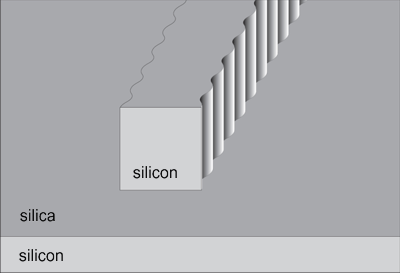FIMMPROPA bi-directional optical propagation tool |
   |
Grating Models: RCMT and EMEModelling gratings and periodic structures with FIMMPROPFIMMPROP allows you to model propagation in gratings and other periodic structures such as Bragg reflectors, polarisation rotators, surface emitters or mode converters; it can model gratings in planar waveguides and optical fibers, as well as more complex geometries. You can choose between two computational methods to model a grating in FIMMPROP: EigenMode Expansion (EME) and a form of Rigorous Coupled Mode Theory (RCMT) recently developed by Photon Design. These two methods are complementary and will allow you to model a variety of different grating geometries accurately and with great efficiency. FIMMPROP can handle short gratings with just a few periods as well long gratings with hundreds or thousands of periods. This gives FIMMPROP a strong benefit over algorithms such as FDTD or finite-element methods which work very well for short gratings but would be unable to handle very long structures.
Benefits of modelling gratings with CMTRCMT is a great complement to EME and allows FIMMPROP to model many otherwise problematic gratings efficiently. It is particularly useful for high index contrast long DBR gratings; in such cases an EME approach would require many modes to converge and would be very slow. At the same time FDTD would be slow because of the long length. The RCMT approach only requires a few modes and can model such gratings much more quickly and accurately. RCMT’s abilities make it an ideal choice for modelling low kappa, long silicon or InP surface relief DBR gratings. Such gratings are becoming very popular for e.g. hybrid InP/silicon laser devices. Benefits of modelling gratings with EMEEME is a very powerful tool for modelling gratings with cylindrical geometries, such as fiber Bragg gratings, as it can take advantage of the cylindrical symmetry and solve the entire problem in cylindrical coordinates. As RCMT is generally limited to the modelling of low-order gratings, EME can be used for modelling high-order gratings such as co-directional couplers and also for surface grating couplers. ApplicationsYou can find a few examples in the links below: Fiber to Chip Vertical Grating Coupler Wide Bandwidth Grating-Assisted Directional Coupler Grating-Assisted Spot-Size Converter Optical Modes of a Laser Cavity (VCSEL, DFB)
|




